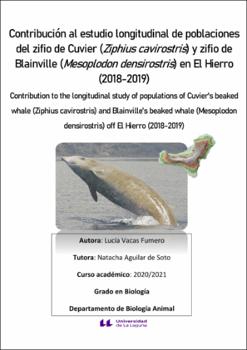Contribución al estudio longitudinal de poblaciones del zifio de Cuvier (Ziphius Cavirostris) y zifio de Blainville (Mesoplodon densirostris) en El Hierro (2018-2019.)
Author
Vacas Fumero, LucíaDate
2021Abstract
This work contributes to the longitudinal study of the populations of Cuvier's and
Blainville's beaked whales in coastal waters of El Hierro, where a strong bathymetry
enables their deep diving. The study is carried out by photographic identification of the
individuals thanks to their natural marks. The results for the period analyzed here
(2018-19) show trends consistent with those registered since the beginning of the study
in 2004. The abundance estimates in 2018-19 are 54 (SD 7.46) and 47 (SD 4.97) for
Blainville´s and Cuvier´s beaked whales, respectively. For both species around half of
the animals show a pattern of residence (R), and the other half are transients (T). The
distribution by sex of R and T for each species coincides with their social structure, with
more R being the sex with longer-lived interindividual alliances (females in Blainville
and males in Cuvier). Estimates of abundance per pairs of years are similar since 2004, suggesting that the population size is limited by the carrying capacity of the area. Given
that this size is low, as well as the reproductive rates, a massive mortality such as those
registered in the Canary Islands coinciding with naval sonars until the declaration of the
moratorium to their use in 2004, could have consequences at the population level. For
this reason, it is necessary that this moratorium is legally formalized. Este trabajo contribuye al estudio longitudinal de la fidelidad territorial de zifios de
Cuvier y de Blainville en aguas costeras de El Hierro, donde la fuerte batimetría
posibilita su buceo profundo. El estudio se realiza por identificación fotográfica de los
individuos gracias a sus marcas naturales. Los resultados para el periodo analizado aquí
(2018-19) muestra tendencias consistentes a las registradas desde el comienzo del
estudio en 2004. La estima de abundancia en 2018-19 es de 54 (SD 7.46) y 47 (SD
4.97) para el zifio de Blainville y de Cuvier, respectivamente. De ellos, la mitad
presenta un patrón de residencia (R), y la mitad son transeúntes (T). La distribución por
sexos de R y T para cada especie coincide con su estructura social, siendo más R el sexo
con alianzas interindividuales más longevas (hembras en Blainville y machos en
Cuvier). Las estimas de abundancia por pares de años son similares desde 2004, lo que
sugiere que el tamaño de la población está limitado por la capacidad de carga del área.
Dado que este tamaño es bajo, así como las tasas reproductivas, una mortandad masiva
como las registradas en Canarias coincidentes con sonares navales hasta la declaración
de la moratoria a su uso en 2004, podría tener consecuencias a nivel poblacional. Por
ello es necesario que esta moratoria se formalice legalmente.





